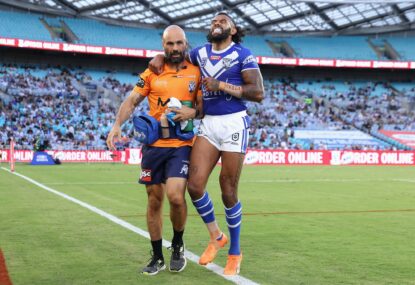NSW humiliated Queensland for 18 years - no wonder the Blues can't match their special breed of hatred
Why are NSW people always so desperate to prove that they “get” Origin, and that Origin means as much south of the Tweed as…

There seems to be an unusually high incidence of injuries to high-profile players in the early part of the current season, but is this just over-reporting or is it statistically supported? Is Phil Gould correct to say there is an over-dramatisation of head injuries and it’s all a storm in a teacup?
It’s time for a proper statistical and evidence-based analysis of the apparent increase in serious injuries in the NRL. This would help the NRL and key decision-makers formulate strategies to measure and reduce injury levels, within the realm of the possible, noting the inherent risks involved in playing the most brutal team sport in the world.
There is a deep reservoir of data available to test reality against perception. The RLPA has plenty of data at its disposal, as do the clubs. There are other reliable collection points such as Brien Seeney’s NRLPhysio Twitter. Back in May 2021, the NRL sought to analyse whether the efforts to create a freer-flowing game caused more fatigue and margin for errors leading to injuries – the NRL concluded otherwise.
At the time, the NRL’s findings about player fatigue created plenty of controversy with some credible figures such as Andrew Johns and Clint Newton disputing the findings. Some pundits claim that more stoppages actually create a higher risk of injuries than a free-flowing game as the players are fresher, and the speed of impact and collisions are consequently heavier.
There is no doubt that players are bigger, faster and stronger than ever before. Equally, players are fitter and access to recovery, rehab and treatment are more advanced, and diet and legal drug treatment are more sophisticated. How do these factors figure in injury statistics? We don’t really know. There will always be a random or luck (or bad luck) element to injuries that hopefully balance out for every club over the span of a season or more.
Even if injury levels are not materially higher than in prior years, they are still noticeably high and the impacts of injuries on the individual player, their teams and fans are hugely significant. A team’s injury level and squad depth is arguably the key predictor of success in a competitive competition like the one we have at the moment.
Getting a better handle on the factors influencing injuries will help us manage player welfare but also drive decisions on rule changes and salary caps and squad sizes. The high reporting and prominence of injuries also has a huge impact on grassroots recruitment as most parents are keenly aware of the risk of injury to their children. Also, no one likes to see the stars of our game sitting on the sidelines with injuries.
I’ve got no answers but some questions to explore:
It would be relatively easy to settle on some terms of reference to undertake a proper review of these matters with the findings to be made available to key stakeholders.